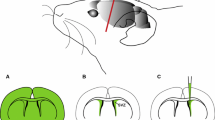Abstract
The development of rational and targeted therapies for human astrocytomas is heavily dependent on our knowledge of its molecular pathogenesis, combined with the generation of appropriate pre-clinical mouse models. The ability to manipulate the mouse genome, which is nearing completion and is highly homologous to its human counterpart, has significantly accelerated our ability to create transgenic mouse models that replicate the pathological and molecular characteristics found in human astrocytomas. These models should serve to further our knowledge of the molecular pathogenesis of human astrocytomas, and serve as useful reagents to test conventional and novel thera-break peutics.
Similar content being viewed by others
References
Ding H, Roncari L, Shannon P, Wu X, Lau N, Karaskova J, Gutmann DH, Squire JA, Nagy A, Guha A: Astrocytespecific expression of activated p21-ras results in malignant astrocytoma formation in a transgenic mouse model of human gliomas. Cancer Res 61: 4425–4431, 2001
Son JH, Chung JH, Huh SO, Park DH, Peng C, Rosenblum MG, Chung YI, Joh TH: Immortalization of neuroendocrine pinealocytes from transgenic mice by targeted tumorigenesis using the tryptophan hydroxylase promoter. Brain Res Mol Brain Res 37: 32–40, 1996
Fung KM, Chikaraishi DM, Suri C, Theuring F, Messing A, Albert DM, Lee VM, Trojanowski JQ: Molecular phenotype of simian virus 40 large T antigen-induced primitive neuroectodermal tumors in four different lines of transgenic mice. Lab Invest 70: 114–124, 1994
Huang CJ, Spinella F, Nazarian R, Lee MM, Dopp JM, de Vellis J: Expression of green fluorescent protein in oligodendrocytes in a time-and level-controllable fashion with a tetracycline-regulated system. Mol Med 5: 129–137, 1999
Weiss WA, Aldape K, Mohapatra G, Feuerstein BG, Bishop JM: Targeted expression of MYCN causes neuroblastoma in transgenic mice. EMBO J 16: 2985–2995, 1997
Rovigatti U, Afanasyeva T, Brandner S, Hainfellner JA, Kiess M, Maddalena A, Malin G, Rulicke T, Steinbach J, Weissenberger J, Aguzzi A: Transgenic mice as research tools in neurocarcinogenesis. J Neurovirol 4: 159–174, 1998
Evans MJ, Kaufman MH: Establishment in culture of pluripotential cells from mouse embryos. Nature 292: 154–156, 1981
Nagy A, Gocza E, Diaz EM, Prideaux VR, Ivanyi E, Markkula M, Rossant J: Embryonic stem cells alone are able to support fetal development in the mouse. Development 110: 815–821, 1990
O'shea KS: Embryonic stem cell models of development. Anat Rec 257: 32–41, 1999
Capecchi MR: Altering the genome by homologous recombination. Science 244: 1288–1292, 1989
DePrimo SE, Stambrook PJ, Stringer JR: Human placental alkaline phosphatase as a histochemical marker of gene expression in transgenic mice. Transgenic Res 5: 459–466, 1996
Garrick D, Fiering S, Martin DI, Whitelaw E: Repeatinduced gene silencing in mammals. Nat Genet 18: 56–59, 1998
Lobe CG, Nagy A: Conditional genome alteration in mice. Bioessays 20: 200–208, 1998
Yergeau DA, Hetherington CJ, Wang Q, Zhang P, Sharpe AH, Binder M, Marin-Padilla M, Tenen DG, Speck NA, Zhang DE: Embryonic lethality and impairment of haematopoiesis in mice heterozygous for an AML1-ETO fusion gene. Nat Genet 15: 303–306, 1997
Mansuy IM, Bujard H: Tetracycline-regulated gene expression in the brain. Curr Opin Neurobiol 10: 593–596, 2000
Nagy A: Cre recombinase: the universal reagent for genome tailoring. Genesis 26: 99–109, 2000
Hamilton DL, Abremski K: Site-specific recombination by the bacteriophage P1 lox-Cre system. Cre-mediated synapsis of two lox sites. J Mol Biol 178: 481–486, 1984
Cichowski K, Shih TS, Schmitt E, Santiago S, Reilly K, McLaughlin ME, Bronson RT, Jacks T: Mouse models of tumor development in neurofibromatosis type 1. Science 286: 2172–2176, 1999
Vogel KS, Klesse LJ, Velasco-Miguel S, Meyers K, Rushing EJ, Parada LF: Mouse tumor model for neurofibromatosis type 1. Science 286: 2176–2179, 1999
Soriano P: Generalized lacZ expression with the ROSA26 Cre reporter strain. Nat Genet 21: 70–71, 1999
Lobe CG, Koop KE, Kreppner W, Lomeli H, Gertsenstein M, Nagy A: Z/AP, a double reporter for cre-mediated recombination. Dev Biol 208: 281–292, 1999
Novak A, Guo C, Yang W, Nagy A, Lobe CG: Z/EG, a double reporter mouse line that expresses enhanced green fluorescent protein upon Cre-mediated excision. Genesis. 28: 147–155, 2000
Metzger D, Clifford J, Chiba H, Chambon, P: Conditional site-specific recombination in mammalian cells using a ligand-dependent chimeric Cre recombinase. Proc Natl Acad Sci USA 92: 6991–6995, 1995
Kellendonk C, Tronche F, Monaghan AP, Angrand PO, Stewart F, Schutz G: Regulation of Cre recombinase activity by the synthetic steroid RU 486. Nucleic Acids Res 24: 1404–1411, 1996
Danks RA, Orian JM, Gonzales MF, Tan SS, Alexander B, Mikoshiba K, Kaye AH: Transformation of astrocytes in transgenic mice expressing SV40 T antigen under the transcriptional control of the glial fibrillary acidic protein promoter. Cancer Res 55: 4302–4310, 1995
Weissenberger J, Steinbach JP, Malin G, Spada S, Rulicke T, Aguzzi A: Development and malignant progression of astrocytomas in GFAP-v-src transgenic mice. Oncogene 14: 2005–2013, 1997
Maddalena AS, Hainfellner JA, Hegi ME, Glatzel M, Aguzzi A: No complementation between TP53 or RB-1 and v-src in astrocytomas of GFAP-v-src transgenic mice. Brain Pathol 9: 627–637, 1999
Theurillat JP, Hainfellner J, Maddalena A, Weissenberger J, Aguzzi A: Early induction of angiogenetic signals in gliomas of GFAP-v-src transgenic mice. Am J Pathol 154: 581–590, 1999
Guha A, Feldkamp MM, Lau N, Boss G, Pawson A: Proliferation of human malignant astrocytomas is dependent on Ras activation. Oncogene, 15: 2755–2765, 1997
Ding H, Wu X, Roncari L, Lau N, Shannon P, Nagy A, Guha A: Expression and regulation of neuropilin-1 in human astrocytomas. Int J Cancer 88: 584–592, 2000
Ding H, Roncari L, Wu X, Lau N, Shannon P, Nagy A, Guha A: Expression and hypoxia regulation of angiopoietins in human astrocytomas. Neuro-Oncology 1: 1–10, 2001
Author information
Authors and Affiliations
Rights and permissions
About this article
Cite this article
Ding, H., Guha, A. Mouse Astrocytoma Models: Embryonic Stem Cell Mediated Transgenesis. J Neurooncol 53, 289–296 (2001). https://doi.org/10.1023/A:1012256230365
Issue Date:
DOI: https://doi.org/10.1023/A:1012256230365




